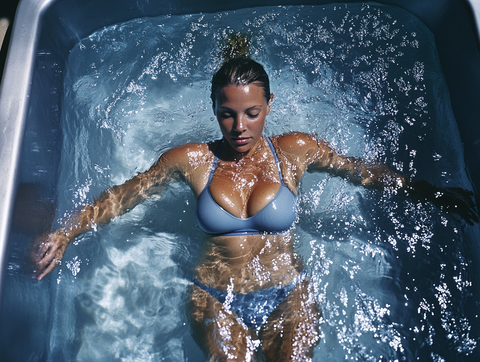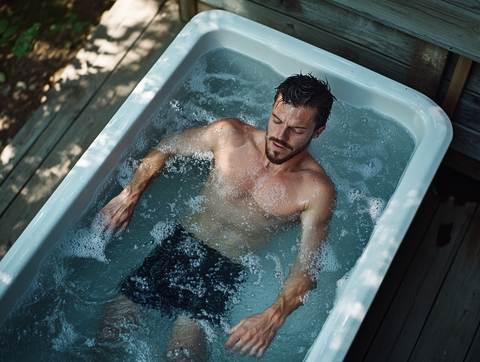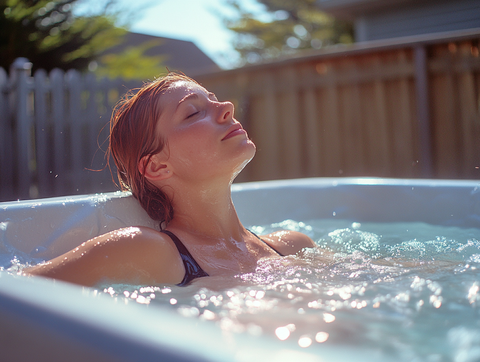
Athletes looking to reduce post-workout muscle soreness, or individuals looking for an experience may find cold immersion appealing,” he says. The practice also serves as a treatment for long-distance endurance athletes who are prone to heat stroke. Cold plunges may have a positive effect on stress management as well.12 Jan 2024
Cold plunge therapy, also known as cold water immersion, has gained widespread popularity within the fitness and wellness communities. Whether you’ve heard of it from athletes, celebrities, or fitness enthusiasts, the practice of submerging the body in cold water after or before exercise is being hailed for its myriad of potential benefits. But when is the optimal time to indulge in a cold plunge? Should you cold plunge before or after workout?
In this article the Arsenal Health + Fitness team will dive into the science, benefits, and practical considerations surrounding cold plunge therapy, providing clarity on how and when to incorporate cold plunge timing into your fitness routine
Cold plunge recovery is gaining massive attention in the wellness world as a potent tool for reducing muscle soreness, boosting recovery, and improving mental clarity. Discover why everyone is jumping in!
Introduction to Cold Plunge Recovery: An Overview
Understanding Cold Plunge Therapy
Cold plunge therapy describes the immersing of the body in cold water, typically around 50-59°F (10-15°C), for a brief period, often ranging from a few minutes to around 10-15 minutes. The practice of frequent cold plunging perhaps dates back to ancient times, with the Greeks and Romans using cold baths as a form of recovery, and it has evolved into a modern fitness and wellness trend.
Popularity in Modern Fitness and Wellness Routines
In recent years, cold plunge or cold water immersion therapy has become a staple in many high-end gyms, spas, and wellness centers, with people turning to it for its purported ability to reduce muscle soreness, enhance recovery, and improve mental resilience. Its growing presence in athletic circles, including among professional sports teams, reflects its effectiveness in supporting recovery and performance.
Scientific Principles Behind Cold Plunges
The primary mechanism behind cold plunges lies in vasoconstriction, where blood vessels constrict in response to colder temperatures. This process reduces blood flow to muscles and tissues, limiting the buildup of inflammation and waste products like lactic acid, which are often associated with muscle soreness. With sufficient rest and after the body warms up again after the plunge, the blood vessels dilate, promoting increased blood circulation and the delivery of fresh oxygen and nutrients to the muscles.
Cold Plunge Techniques
Cold plunging should not be done carelessly or taken lightly. Here are a few things to consider for a safe cold plunge before or after workout sessions.
- Optimal Water Temperature & Duration: Cold plunges should generally be in the range of 50-59°F (10-15°C). Beginners should aim for around 3-5 minutes, while experienced users may extend this to 10 minutes.
- Breathing Techniques During a Cold Plunge: Focused, deep breathing is essential to help manage the shock of cold exposure. Slow, controlled breaths can prevent hyperventilation and improve overall tolerance.
- Safety Precautions: Always ensure proper supervision and avoid prolonged exposure to cold water. If you have pre-existing health conditions (e.g., heart disease), consult a doctor before incorporating cold plunges into your routine and cold plunge safely
In recent years, cold plunge recovery, also known as cold water immersion or ice baths, has emerged as a powerful recovery tool for athletes, fitness enthusiasts, and wellness seekers. After intense workouts or physical activities, many people are increasingly turning to this method to relieve soreness, reduce inflammation, and speed up muscle recovery. But why is it gaining so much attention, and does the science back up its growing popularity?
Cold plunge therapy isn’t a new concept. It has been practiced for centuries in cultures around the world, with ancient civilizations using cold baths as a means of promoting healing, rejuvenating muscles, and boosting overall well-being. Today, it has evolved into a modern wellness trend, being promoted by elite athletes, fitness trainers, and even health influencers on social media. With the growing body of research supporting its benefits, more people are eager to experience the rejuvenating effects of a cold plunge for themselves.
In this article, we’ll dive deep into the mechanics of cold plunge recovery, the science behind its effectiveness, and how it can transform your fitness and recovery routines. From the physiological benefits to the mental clarity it offers, we’ll cover everything you need to know about this powerful recovery tool.
How Cold Plunge Recovery Works
Understanding Cold Water Immersion

Cold plunge recovery involves immersing the body in cold water typically at temperatures ranging from 50°F to 59°F (10°C to 15°C), for a period of time (usually 10 to 15 minutes). This process causes the blood vessels to constrict and reduces blood flow to the muscles, which helps reduce inflammation and muscle soreness.
Once the body is removed from the cold water, blood flow returns to the muscles, flushing out metabolic waste products like lactic acid and bringing in fresh oxygenated blood, which accelerates recovery. The combination of reduced inflammation and improved circulation helps to alleviate post-exercise muscle soreness and can even speed up the repair of damaged tissues.
The Science Behind Cold Plunge Recovery
While cold plunge recovery has been used for centuries, scientific research has only recently begun to catch up. Numerous studies have examined the physiological effects of cold exposure, and the results are compelling.
One study published in the Journal of Sports Science and Medicine concluded that cold water immersion was effective at reducing muscle soreness and improving recovery times for athletes. The study participants reported feeling less fatigued and having reduced muscle pain after using ice baths following intense training sessions.
Cold water immersion works on the principle of vasoconstriction. When the body is exposed to cold temperatures, blood vessels constrict, limiting the flow of blood to the affected muscles. This reduces inflammation and decreases the sensation of pain. Once the body warms up after exiting the cold water, the blood vessels dilate, bringing fresh blood (rich in oxygen and nutrients) back to the muscles to speed up recovery.
Cold Plunge vs. Other Recovery Techniques
While cold plunge recovery is gaining traction, it’s important to understand how it compares to other popular recovery techniques like foam rolling, stretching, and traditional rest. Each method offers unique benefits, but cold plunge therapy stands out due to its ability to reduce inflammation rapidly and relieve deep muscle soreness more effectively than other methods.
Foam rolling and stretching are excellent for improving flexibility, reducing tension, and increasing blood flow, but they don’t offer the immediate and drastic anti-inflammatory effects that a cold plunge can provide. Rest is also essential for recovery, but it doesn’t actively target muscle inflammation in the way cold exposure does.
The Benefits of Cold Plunge Recovery
1. Reduced Muscle Soreness and Inflammation
One of the most well-known benefits of cold plunge recovery is its ability to reduce muscle soreness and inflammation. After intense physical activity, muscle fibers can become inflamed, leading to the uncomfortable feeling of delayed onset muscle soreness (DOMS). By constricting blood vessels and reducing the flow of inflammatory molecules to the muscles, cold immersion helps mitigate this soreness.
A study in the International Journal of Sports Physiology and Performance found that athletes who used cold water immersion reported significantly lower levels of muscle soreness after exercise, compared to those who used other recovery methods.
2. Faster Recovery and Reduced Fatigue
Another significant benefit of cold plunge recovery is its ability to speed up recovery. The process of cold water immersion helps flush out metabolic waste products from muscles and tissues, accelerating the body’s natural repair process. It also reduces the build-up of lactic acid, a byproduct of intense exercise that contributes to muscle fatigue and soreness.
By improving circulation, cold plunges facilitate the delivery of nutrients and oxygen to muscles, helping to repair damaged tissue and recover more quickly. This allows athletes to return to their training routines with less downtime and a reduced risk of overtraining.
3. Enhanced Mental Clarity and Focus
Cold plunge therapy isn’t just beneficial for your body; it can also have significant mental benefits. Cold exposure has been shown to activate the body’s sympathetic nervous system, which triggers a “fight-or-flight” response, increasing alertness, focus, and energy. Many people report feeling mentally refreshed and more focused after a cold plunge session.
This mental clarity can be particularly valuable after a tough workout or a long day. The cold plunge acts as a reset, helping to clear mental fog and improve cognitive function. For athletes and fitness enthusiasts, staying sharp mentally is just as important as physical recovery.
4. Improved Circulation and Immune Function
Cold plunge recovery can also enhance overall circulation, which is essential for maintaining good health. Regular cold exposure helps stimulate blood flow to the muscles and organs, improving cardiovascular health over time. Moreover, cold immersion is thought to stimulate the lymphatic system, which plays a crucial role in detoxifying the body and boosting immune function.
Research published in the European Journal of Applied Physiology suggests that cold water immersion may also increase the production of white blood cells, which are responsible for fighting off infections and boosting overall immune defense. As such, cold plunge therapy may be an excellent tool for strengthening your immune system, especially during periods of intense physical activity.
5. Reduced Stress and Anxiety

Cold exposure has been shown to reduce stress hormones, such as cortisol, which can be elevated during periods of intense exercise or mental strain. A study published in the International Journal of Stress Management found that individuals who regularly practiced cold water immersion reported lower levels of stress and anxiety.
By stimulating the vagus nerve, which plays a role in regulating the body’s stress response, cold plunges can help you feel more relaxed and at ease. This can improve mental well-being and help you recover from the emotional stresses of both exercise and daily life.
How to Safely Use Cold Plunge Recovery
1. Start Slowly
If you’re new to cold plunge recovery, it’s important to ease into it. Begin with shorter sessions, around 3 to 5 minutes, and gradually increase the duration as your body becomes accustomed to the cold exposure. Some individuals may find that they need to start with slightly warmer temperatures (around 60°F or 15°C) before working their way down to colder temperatures.
2. Monitor Your Body’s Response
While cold plunge recovery is generally safe for most people, it’s important to listen to your body. If you feel lightheaded, dizzy, or excessively uncomfortable during the session, it’s essential to exit the cold water immediately. Always pay attention to how your body responds, and never stay in the water for longer than you feel comfortable.
3. Post-Plunge Warm-Up
After completing a cold plunge session, it’s crucial to warm up your body gradually. This can be done by taking a warm shower, engaging in light exercise, or simply resting under a blanket. Warming up helps to restore normal blood circulation and prevent shock to the body.
The Rise of Cold Plunge Therapy in Wellness Culture
Cold plunge therapy is no longer reserved just for athletes or elite fitness enthusiasts. Its growing popularity among wellness culture enthusiasts, biohackers, and even everyday people reflects the increasing trend towards recovery-focused self-care. With the rise of holistic wellness practices, people are now exploring various techniques to optimize their physical and mental health, and cold plunge therapy has carved a significant niche in this space.
What’s driving this widespread adoption? Much of it can be attributed to social media influencers, fitness coaches, and athletes who openly share their experiences with cold plunge recovery, showing how it aids them in reducing stress, speeding up recovery, and improving performance. As more people talk about their positive experiences with cold plunges, others are motivated to try it for themselves.
Furthermore, wellness brands and health retreats are also beginning to incorporate cold plunge pools and cryotherapy chambers into their offerings, making these recovery tools more accessible to the general public. Many high-end spas and gyms now feature cold plunge options alongside saunas and steam rooms, allowing customers to complete a full recovery routine that promotes both physical and mental rejuvenation.
This integration of cold plunge therapy into wellness offerings points to the broader societal shift toward prioritizing recovery and self-care. As individuals become more attuned to the importance of rest, repair, and rejuvenation in achieving their fitness goals, tools like cold plunge therapy are seen as critical in optimizing their results.
Can Cold Plunge Recovery Benefit Non-Athletes?
While cold plunge therapy is widely regarded as an essential recovery tool for athletes, it’s equally beneficial for non-athletes looking to improve their overall health and wellness. Cold plunges can help people who spend long hours sitting at desks, dealing with chronic stress, or suffering from common aches and pains due to physical inactivity or poor posture.
For office workers or those who spend most of the day sitting, cold plunge therapy can help reduce the effects of prolonged inactivity by promoting blood circulation and encouraging muscle recovery. Additionally, regular cold immersion may help with stress reduction, which is an issue that many non-athletes face due to demanding work environments and personal commitments.
Moreover, for those recovering from physical ailments or injuries unrelated to sports, cold plunge therapy can be a gentle yet effective way to manage chronic pain or reduce swelling after surgeries. The ability of cold immersion to promote circulation, decrease inflammation, and support faster tissue repair makes it an excellent addition to rehabilitation protocols.
Cold Plunge for Stress Relief
Stress and anxiety are issues that many people face daily, whether due to work, relationships, or other life challenges. Cold plunge therapy has shown to be a powerful stress-relief tool due to its impact on the nervous system. When exposed to cold water, the body activates the sympathetic nervous system, also known as the “fight-or-flight” response, which leads to the release of stress-reducing hormones like norepinephrine.
These hormones help combat feelings of anxiety, clearing mental fog and enhancing focus. The cold exposure also triggers the parasympathetic nervous system once the person exits the cold plunge, promoting a calming “rest-and-digest” response. This combination of heightened alertness followed by deep relaxation offers profound relief for individuals grappling with chronic stress.
How Cold Plunge Recovery Fits Into Your Routine
If you’re considering incorporating cold plunge recovery into your routine, it’s important to understand how to use it effectively. Here are a few tips on how to integrate cold plunge therapy into your wellness routine:
- Post-Workout Cold Plunge
The most common time to use cold plunge recovery is immediately after a workout. After an intense session, your muscles are fatigued and inflamed. Cold immersion can help alleviate soreness and accelerate recovery by flushing out lactic acid and reducing muscle inflammation.
A typical cold plunge session should last around 10-15 minutes. Make sure your body is cooled down before immersing yourself to avoid shock, and ensure that you have access to a warm environment afterward to gradually return your body to normal
temperature.
2. Morning Cold Plunge

Some people prefer to start their day with a cold plunge to invigorate the body and mind. Cold water exposure first thing in the morning can stimulate the nervous system and boost alertness, leaving you feeling energized for the day ahead. It can also help with mental clarity and focus, which is particularly beneficial if you have a busy day ahead or need to tackle mentally demanding tasks.
3. Cold Plunge for Stress Management
If you’re using cold plunge therapy to reduce stress, consider taking a session at the end of a workday to unwind. It can help reset your nervous system and give you a sense of calm and relaxation before heading into the evening. It also provides a healthy way to de-stress without relying on substances like alcohol or caffeine.
4. Incorporating Cold Plunge into Wellness Retreats
For those who are seeking an immersive wellness experience, many wellness retreats and spas are now incorporating cold plunge therapy as part of their recovery packages. These retreats typically offer a combination of cold plunge sessions, saunas, steam rooms, and massages, creating a holistic recovery experience that promotes both physical and mental well-being.
Cold Plunge: The Future of Fitness Recovery
As the wellness and fitness industries continue to evolve, it’s clear that recovery practices are becoming just as important as the workout itself. Cold plunge therapy is leading the charge in this trend, offering numerous benefits for both professional athletes and everyday individuals. Its ability to reduce muscle soreness, enhance mental clarity, improve circulation, and alleviate stress is making it a must-try for anyone looking to optimize their health and wellness routines.
While cold plunge therapy is not a one-size-fits-all solution and may not be suitable for everyone, its growing popularity is a testament to its effectiveness in improving recovery. With continued research into its benefits and greater accessibility in wellness spaces, cold plunge recovery is poised to become an integral part of fitness culture worldwide.
For those who embrace it, cold plunge therapy represents more than just a recovery tool—it’s a holistic approach to improving physical and mental health, one cold plunge at a time
Conclusion
Cold plunge recovery has firmly established itself as a powerful, scientifically-supported recovery tool that offers numerous benefits for physical and mental well-being. Whether you are an athlete pushing your body to its limits or simply someone seeking a holistic approach to self-care, cold plunge therapy can be a game-changer in enhancing your recovery. From reducing muscle soreness and inflammation to improving circulation, boosting mental clarity, and aiding in stress management, cold water immersion has proven to be more than just a passing trend.
The growing body of evidence supporting its efficacy, combined with the rise of wellness culture and accessible recovery-focused amenities, suggests that cold plunge recovery will only become more mainstream. As more people begin to experience the positive effects of this ancient technique, it’s likely to gain further traction among a broader audience.
While cold plunge therapy isn’t for everyone, it can be a highly effective addition to many fitness routines, especially when used appropriately and in combination with other recovery practices. It’s important to listen to your body and ensure that you’re using this therapy safely and in moderation. Whether used for post-workout recovery, stress relief, or simply for a mental reset, cold plunge recovery offers numerous benefits that can optimize your overall health and well-being.